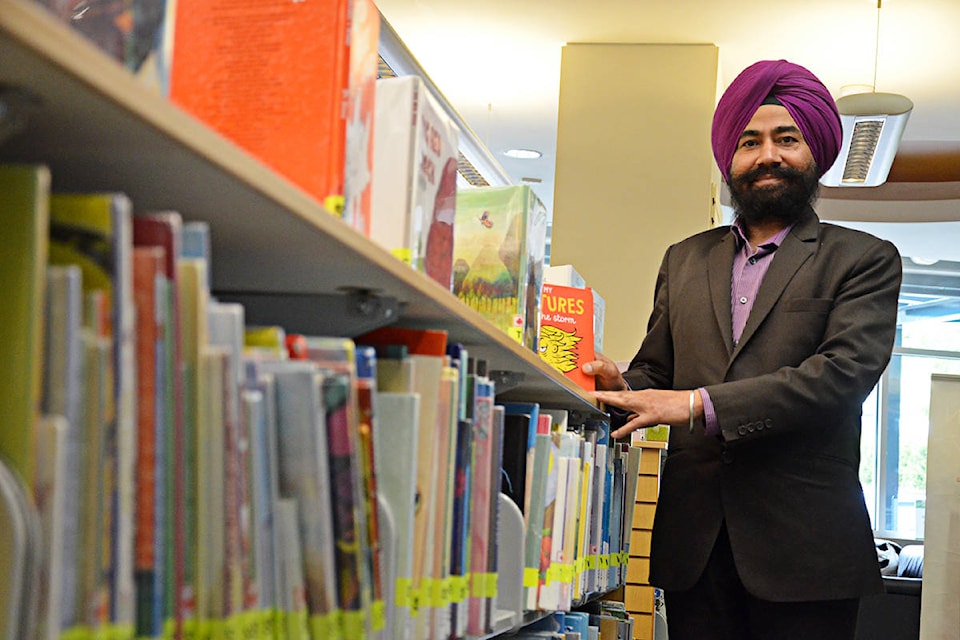The number of library users in Langley and its Fraser Valley neighbours has shot up dramatically in recent years, even as the budget for new books has grown more slowly.
There were 330,528 people with library cards in the area served by the Fraser Valley Regional Library (FVRL) in 2017, a 24.1 per cent increase from 266,178 active cardholders just three years earlier.
That’s far faster than growth in the population the FVRL serves, which rose from 706,117 in 2014 to 722,593 in 2017, just a 2.3 per cent increase.
“Definitely the population is growing, more and more people are using the libraries,” said Dr. Sarwan Randhawa, the community librarian at Muriel Arnason Library in Willowbrook.
However, that doesn’t necessarily mean that more people are coming in and using library services in person, he noted. Many people have switched from in-person visits and physical book loans to using the library’s website and its growing collection of ebooks.
In 2017, the library saw 5.69 million loans of physical books, DVDs, CDs and other materials. In addition, there were 495,256 downloads of ebooks, audiobooks, and digital magazines.
In 2014, there were more loans of physical items – 6.78 million items – but downloads were at just 406,254.
The library system has also been expanding its mandate in recent years, adding a host of new programs, including loans for Sphero toy robots, ukuleles, and a makerspace program.
“Definitely, there’s a little bit of more work,” said Randhawa. “The other side of the picture is the technology is improving.”
The librarians at Muriel Arnason and other branches keep busy introducing more people to how to use the online systems and ebooks, Randhawa said. Seniors and new Canadians are among those who benefit most from the help.
But eventually, new libraries will be needed.
“If we keep the same level of services, we will not be able to serve everybody,” Randhawa said.
The FVRL has increased its budget in recent years, asking for more money from its member municipalities for shared costs such as book purchasing. Several communities, including Delta, Port Coquitlam, and White Rock have seen councillors suggest leaving the system and striking out on their own.
The FVRL has also run into issues with increased costs, such as a US-Canadian exchange rate that has made buying books more expensive, noted Langley City Councillor Gayle Martin, currently the chair of the FVRL board.
“The public knows the library is there,” Martin said. “But do they know it’s funded through their taxes?”
She said she wished the library system had a higher profile, but said it is well run and has good service levels.
Although the FVRL serves more people, it spends less annually on new materials than the Vancouver Public Library system.
In 2017, the FVRL spent $1,034,128 on library materials, including books, DVDs and other items, to serve a population of 722,593 people.
In comparison, VPL spent $1,596,264 on books and materials in the same year. Vancouver had a population of about 675,000 that year.
Additionally, FVRL spending on books in 2017 was down from 2016, when the FVRL spent $1,112,589 on books and materials.
Direct comparisons of spending and costs with other local library systems are difficult because FVRL is a distributed system, with the FVRL covering salaries, book purchases, and library operations, while the local municipal governments pay for such things as utilities, janitorial services, security, and building upgrades in their jurisdictions.
But in 2017, based on its budget, the VPL spent about $73.82 per Vancouver resident on the library system.
In comparison, the FVRL spends about $33 to $34 per resident directly through its main budget. Added to that is between $2 to $5 per person spent by the member municipalities, said Nancy Gomerich, the FVRL director of finance.
The Township is likely on the high end of spending because of its many community libraries, Gomerich noted.
The FVRL has 25 library branches and an administrative centre, covering an area that includes Delta, Langley, Port Coquitlam, Abbotsford, Chilliwack, and as far east as the small Fraser Canyon community of Boston Bar.
When it was founded in 1930, the region it served was almost entirely rural. A 1927 survey had found that resources could be shared across towns that couldn’t afford library services of their own. The first regional “library” was the Fraser Valley Book Van, a truck that hauled books across 24 communities and about 2,600 square kilometres. It worked in conjunction with the existing libraries in larger towns.
